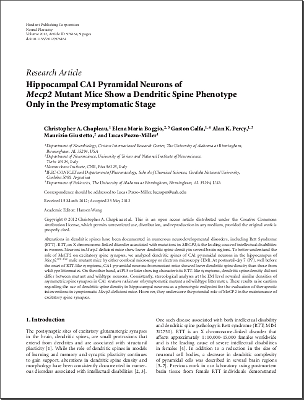Alterations in dendritic spines have been documented in numerous neurodevelopmental disorders, including Rett Syndrome (RTT). RTT, an X chromosome-linked disorder associated with mutations in MECP2, is the leading cause of intellectual disabilities in women. Neurons in Mecp2-deficient mice show lower dendritic spine density in several brain regions. To better understand the role of MeCP2 on excitatory spine synapses, we analyzed dendritic spines of CA1 pyramidal neurons in the hippocampus of Mecp2tm1.1Jae male mutant mice by either confocal microscopy or electron microscopy (EM). At postnatal-day 7 (P7), well before the onset of RTT-like symptoms, CA1 pyramidal neurons from mutant mice showed lower dendritic spine density than those from wildtype littermates. On the other hand, at P15 or later showing characteristic RTT-like symptoms, dendritic spine density did not differ between mutant and wildtype neurons. Consistently, stereological analyses at the EM level revealed similar densities of asymmetric spine synapses in CA1 stratum radiatum of symptomatic mutant and wildtype littermates. These results raise caution regarding the use of dendritic spine density in hippocampal neurons as a phenotypic endpoint for the evaluation of therapeutic interventions in symptomatic Mecp2-deficient mice. However, they underscore the potential role of MeCP2 in the maintenance of excitatory spine synapses.
Hippocampal CA1 Pyramidal Neurons of Mecp2 Mutant Mice Show a Dendritic Spine Phenotype Only in the Presymptomatic Stage


